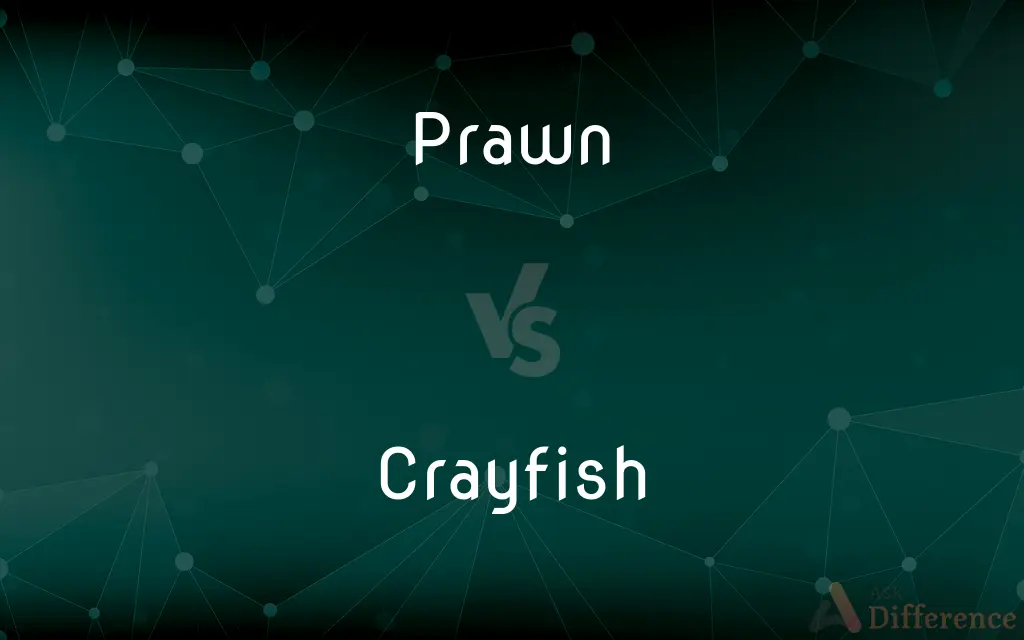Prawn vs. Crayfish — What's the Difference?
By Urooj Arif & Fiza Rafique — Updated on April 16, 2024
Prawns are marine creatures found in saltwater, characterized by their elongated bodies and slender legs, while crayfish are freshwater inhabitants, known for their shorter, stouter forms and strong claws.

Difference Between Prawn and Crayfish
Table of Contents
ADVERTISEMENT
Key Differences
Prawns inhabit saltwater environments, thriving in oceans and seas, which influences their diet and behaviors, while crayfish are predominantly found in freshwater sources like rivers, lakes, and streams, adapting to different ecological niches.
Prawns possess a body structure with a segmented shell that overlaps downwards from head to tail, which aids in swimming. In contrast, crayfish have a more robust shell structure with the second segment overlapping the first and third, suited for a bottom-dwelling lifestyle.
When it comes to reproduction, prawns release their eggs into the water to develop independently, reflecting their adaptation to open water environments. Meanwhile, crayfish carry their fertilized eggs attached to the undersides of their tails until they hatch, providing protection in their more variable freshwater habitats.
Culinary preferences for prawns and crayfish vary globally; prawns are widely celebrated in dishes like paella and shrimp cocktail, prized for their delicate, sweet flavor. Conversely, crayfish are a staple in regional cuisines, such as in the Southern United States and Scandinavia, often enjoyed in social gatherings like crawfish boils.
Prawns are generally larger and have longer legs which are adapted for swimming, while crayfish have larger, more powerful claws used for defense and manipulating objects, reflecting their respective adaptations to open waters and more cluttered, bottom environments.
ADVERTISEMENT
Comparison Chart
Habitat
Saltwater
Freshwater
Body Structure
Elongated body, slender legs
Shorter body, stout claws
Reproduction
Eggs released into the water
Eggs carried on underside
Culinary Use
Common in delicate seafood dishes
Featured in robust, communal meals
Adaptations
Longer legs for swimming
Powerful claws for defense
Compare with Definitions
Prawn
Culturally important in seafood cuisine.
Prawn cocktails are a popular starter in many European countries.
Crayfish
Has distinct, strong claws.
Crayfish use their claws for defense and to capture food.
Prawn
Reproduces by releasing eggs.
Female prawns release thousands of eggs, which float freely.
Crayfish
A freshwater crustacean similar to a small lobster.
Crayfish burrow under rocks in rivers and lakes.
Prawn
A marine crustacean with a slender body.
Prawns are often used in sushi dishes.
Crayfish
Central in various cultural dishes.
In Louisiana, crayfish boils are a celebrated tradition.
Prawn
Known for swimming ability.
Prawns use their long legs to swim swiftly in the ocean.
Crayfish
Carries eggs on its tail.
Female crayfish can be seen with eggs attached to their swimmerets.
Prawn
Found predominantly in saltwater.
Prawns are harvested from oceans around the globe.
Crayfish
Inhabits rivers and lakes.
Crayfish are often caught using baited traps in freshwater bodies.
Prawn
Prawn is a common name for small aquatic crustaceans with an exoskeleton and ten legs (which is a member of the order decapoda), some of which can be eaten.The term "prawn" is used particularly in the United Kingdom, Ireland, and Commonwealth nations, for large swimming crustaceans or shrimp, especially those with commercial significance in the fishing industry. Shrimp that are present in this category often belong to the suborder Dendrobranchiata.
Crayfish
Crayfish are freshwater crustaceans resembling small lobsters (to which they are related). In some parts of the United States, they are also known as crawfish, craydids, crawdaddies, crawdads, freshwater lobsters, mountain lobsters, rock lobsters, mudbugs, or yabbies.
Prawn
Any of various shrimps, especially one that is large or inhabits fresh water.
Crayfish
Any of various freshwater crustaceans of the families Astacidae and Cambaridae of the Northern Hemisphere and the family Parastacidae of the Southern Hemisphere, resembling a lobster but considerably smaller. Also called mudbug; also called regionally crawdad.
Prawn
The flesh of a prawn, used as food.
Crayfish
See spiny lobster.
Prawn
To fish for prawns.
Crayfish
Any of numerous freshwater decapod crustaceans in superfamily Astacoidea or Parastacoidea, resembling the related lobster but usually much smaller.
Prawn
A crustacean of the suborder Dendrobranchiata.
Crayfish
A freshwater crustacean (family Cambaridae), sometimes used as an inexpensive seafood or as fish bait.
Prawn
(Commonwealth) A crustacean, sometimes confused with shrimp.
Crayfish
A rock lobster (family Palinuridae).
Prawn
Synonym of butterface: A woman with an attractive body but an unattractive face.
She's a prawn!
Crayfish
(AU) A freshwater crayfish (family Parastacidae), such as the gilgie, marron, or yabby.
Prawn
A fool, an idiot.
Crayfish
(Singapore) The species Thenus orientalis of the slipper lobster family (Scyllaridae).
Prawn
Alternative form of porn.
Crayfish
To catch crayfish
Prawn
(intransitive) To fish for prawns.
Crayfish
(to backpedal, desert, or withdraw)
Prawn
Any one of numerous species of large shrimplike Crustacea having slender legs and long antennæ. They mostly belong to the genera Pandalus, Palæmon, Palæmonetes, and Peneus, and are much used as food. The common English prawn is Palæmon serratus.
Crayfish
See Crawfish.
Prawn
Any of various edible decapod crustaceans
Crayfish
Warm-water lobsters without claws; those from Australia and South Africa usually marketed as frozen tails; caught also in Florida and California
Prawn
Shrimp-like decapod crustacean having two pairs of pincers; most are edible
Crayfish
Tiny lobster-like crustaceans usually boiled briefly
Prawn
Fish for prawns
Crayfish
Small freshwater decapod crustacean that resembles a lobster
Crayfish
Large edible marine crustacean having a spiny carapace but lacking the large pincers of true lobsters
Common Curiosities
How do prawns and crayfish reproduce?
Prawns release their eggs into the water, while crayfish carry their eggs on their undersides.
What are the typical uses of prawns and crayfish in cuisine?
Prawns are used in delicate seafood dishes, while crayfish are featured in robust, communal meals like crawfish boils.
Can prawns and crayfish be found in the same environments?
No, prawns are marine animals, whereas crayfish are strictly freshwater dwellers.
What habitats do prawns and crayfish prefer?
Prawns live in saltwater, while crayfish are found in freshwater environments.
What are the defensive adaptations of crayfish?
Crayfish have powerful claws used for defense against predators and for handling food.
How do the body structures of prawns and crayfish differ?
Prawns have elongated bodies and slender legs suited for swimming, whereas crayfish have stouter bodies with large claws for defense.
Are crayfish eaten worldwide?
While popular in certain regions like the Southern U.S. and Scandinavia, crayfish are not as globally consumed as prawns.
What culinary dishes are common for prawns?
Dishes like prawn paella, shrimp cocktail, and various sushi forms feature prawns.
Do prawns have any specific adaptations for their habitat?
Yes, prawns have adapted to open saltwater environments with features like longer legs for better swimming capabilities.
How do the flavors of prawns and crayfish compare?
Prawns have a sweeter, more delicate flavor, whereas crayfish offer a richer, more robust taste.
Are crayfish considered invasive species anywhere?
Yes, certain species of crayfish have become invasive in environments outside their native ranges, impacting local ecosystems.
How are prawns and crayfish used in celebrations?
Prawns often appear in formal dishes and seafood platters, while crayfish are the centerpiece of casual, social gatherings like boils.
What is the significance of crayfish in ecology?
Crayfish play a key role in aquatic ecosystems, helping to maintain the cleanliness of river beds and providing food for a variety of predators.
What size are prawns compared to crayfish?
Prawns generally grow larger than most freshwater crayfish.
What economic impact do prawns have?
Prawns are a significant part of the global seafood industry, important in both wild catch and aquaculture.
Share Your Discovery

Previous Comparison
Adapter vs. Converter
Next Comparison
Proteasome vs. ProteaseAuthor Spotlight
Written by
Urooj ArifUrooj is a skilled content writer at Ask Difference, known for her exceptional ability to simplify complex topics into engaging and informative content. With a passion for research and a flair for clear, concise writing, she consistently delivers articles that resonate with our diverse audience.
Co-written by
Fiza RafiqueFiza Rafique is a skilled content writer at AskDifference.com, where she meticulously refines and enhances written pieces. Drawing from her vast editorial expertise, Fiza ensures clarity, accuracy, and precision in every article. Passionate about language, she continually seeks to elevate the quality of content for readers worldwide.














































